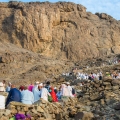In the heart of Yucatán, Mexico, a constellation of ancient Maya cities rises among gentle hills and low vegetation: Uxmal, Kabah, Sayil, Xlapak, and Labná. Collectively known as the Puuc Route—puuc meaning “hill” in the Maya language—these sites were not only political and artistic centers during the Classic Period (c. 250 – 900 CE) but also stages for sacred movement and ritual travel.
Today, the Puuc Route can be experienced on foot or by road as a cultural itinerary through a landscape shaped by architecture, mythology, and environmental adaptation. More than a lesson in archaeology, it is an encounter with encoded environments where stone structures preserve ancestral intentions that continue to resonate among the living cultures of the region.
Ritual Movement and Sacred Connectivity
For ancient Maya societies, travel often held ritual significance. White-stucco ceremonial roads, or sacbéob, linked cities, shrines, and caves—territorial and cosmological nodes. To walk them was to activate a form of communication with the forces believed to structure the universe.
The Puuc Route comprised one such sacred network. Beyond its administrative or commercial functions, it was a path of symbolic progression. Each city represented a stage in cycles of fertility, knowledge, or transformation. The route’s spatial logic mirrored the metaphysical journeys embedded in Maya cosmology.
Uxmal: Center of Ritual Learning
The route begins in Uxmal, the region’s most prominent ceremonial center. Its architectural scale and iconography suggest a place of initiation and celestial observation. The Pyramid of the Magician, a structure associated with local legends, stands as a visual axis of the city. In front of it lies the Nunnery Quadrangle, likely used for specialized instruction in astronomy, healing, or calendrical systems.
The Governor’s Palace, precisely aligned with the rising point of Venus, illustrates the integration of political authority and astronomical knowledge. Visitors arriving at dawn or dusk often report a sense of altered awareness—a legacy of the site’s original intention as a space of cosmic orientation.
From Uxmal to Kabah: Through Hills in Search of Water
The road that links Uxmal and Kabah, still visible in certain sections, served both physical and symbolic purposes. In a region lacking surface rivers, the Maya relied on rainfall and artificial cisterns. Movement across this landscape echoed the vital search for water—a resource not only essential but also considered sacred.

Kabah: The Sculpted Faces of Rain
Kabah is distinguished by the Palace of the Masks, whose façade is adorned with over 250 representations of Chaac, the rain-associated deity. These repeated visages are not ornamental but invoke a form of visual supplication. Walking along this façade invites reflection on the role of ritual architecture in ensuring ecological stability and social continuity.
Sayil and Xlapak: Everyday Sacred Forms
Sayil and Xlapak, the next sites on the route, offer a glimpse into the integration of the sacred within daily life. Their buildings are less monumental but rich in symbolic features—serpent motifs, columned porticos resembling traditional dwellings, and persistent references to Chaac. These cities reveal a form of inhabited sanctuary, where domestic life was infused with cosmological meaning.
Labná: The Threshold as Portal
The final site, Labná, is known for its ceremonial arch—an architectural threshold that held symbolic rather than functional significance. In Maya worldview, passing through such an arch was a metaphysical act, marking a transition between states of being or phases of time. Modern visitors, whether aware or not, reenact this ritual gesture, stepping across a boundary defined as much by belief as by stone.
Symbolic codes in Architecture

To move through the Puuc Route is to navigate a landscape of encoded messages. The repetition of Chaac’s face is a stone-carved invocation of rain and fertility. Intertwined serpents reference cycles of life and renewal, associated with water and with Kukulkán, the plumed serpent. Arched gateways speak of transitional states. Columns that mimic household walls reflect the sacred nature of the home. Alignments with celestial events, especially the movement of Venus, underscore how time and space were ritualized in Maya planning.
Enduring Practices
Contemporary Maya communities continue to engage with this heritage. Rain-invoking ceremonies such as Ch’a Cháak are still performed during the agricultural season, maintaining connections with ancestral ritual frameworks. Tourists today may witness or participate in adapted versions of these ceremonies, particularly in educational settings like the Choco-Story museum or during solar events such as the equinoxes.
A Living Itinerary
Traveling the Puuc Route is not simply a tour through archaeological remnants. It is a passage through a cultural landscape where built forms, environmental adaptations, and symbolic gestures converge. Each site marks a step; each structure encodes meaning; each climb up a stairway echoes movements once shaped by ritual purpose.
While today’s visitors may carry guidebooks and cameras, they traverse a path once walked by ceremonial travelers whose knowledge systems, though partially veiled, still resonate in the rhythms of stone and earth. The Puuc Route is not a ruin—it is a living echo, a corridor into the intellectual and spatial imagination of the ancient Maya.




